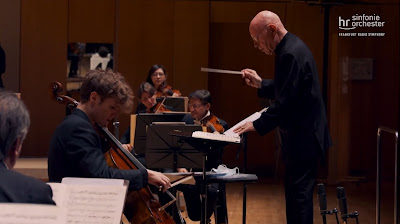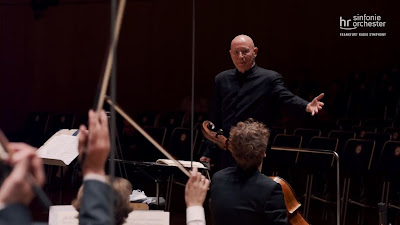Accompanied by the Frankfurt Radio Symphony Orchestra under the baton of the great conductor Christoph Eschenbach, the award-winning French cellist Bruno Philippe performs Camille Saint-Saëns' Cello Concerto No.1 in A minor, Op.33. The concert was recorded at Hr Sendesaal, Frankfurt, Germany, on September 17, 2020.
✻
The first cello concerto has always been one of Saint-Saëns' most popular pieces, Casals choosing it for his London debut in 1905. Tunes abound, but not in any disorderly way: the main themes of the outer movements move upwards, the second themes downwards; if, that is, the opening cello motif can be called a "theme' – the composer's biographer Brian Rees refers to it as "an artefact rather than a melodious outburst". The central minuet is a movement of pure delight and, in those uncertain times, no doubt reassured Parisian audiences that French culture had after all survived, one critic remarking that here the composer was making up for a recent "divergence from classicism". The return of earlier material in the third movement may owe something to Saint-Saëns' study of the cyclic patterns found in Liszt, to whom he remained indebted all his life.
Saint-Saëns' Cello Concerto No.1 in A minor, Op.33, was informed, certainly, by one friendship and possibly by another. As a student, he had been taught piano accompaniment by Auguste Franchomme, the cellist to whom Chopin had dedicated his cello sonata and who developed a particular light bowing technique usually described as "French". Another possible influence on the work was the death in January 1872 of his beloved great-aunt Charlotte at the age of ninety-one, after which he cancelled all engagements for a month. It is arguable that the tone of the work combines a lightness of touch with deep expressiveness, not least in what one biographer has called the "haunting otherworldliness" of its melodies.
Yet a third factor in the work might well have been the incipient recovery of Paris after the Franco-Prussian war and the Commune. In February 1871 the new Société Nationale de Musique, with Saint-Saëns as one of its founder members, had promoted its first concert under the banner "Ars gallica", and the impetus was thereby given to young French composers to outdo the Germans in every way possible. It was partly pressure from the Société that pushed the staid Concerts du Conservatoire into accepting the premiere of Saint-Saëns' first concerto on 19 January 1873, but more the request from the established cellist Auguste Tolbecque – without which, the conductor kindly informed the composer, the work would not have had a hope.
Source: Roger Nichols (hyperion-records.co.uk)
i. Allegro non troppo
ii. Allegretto con moto
iii. Tempo primo
Bruno Philippe, cello
hr-Sinfonieorchester (Frankfurt Radio Symphony Orchestra)
Conductor: Christoph Eschenbach
Hr Sendesaal, Frankfurt, Germany, September 17, 2020
(HD 1080p)
Among the prestigious soloists with whom he has appeared are Gary Hoffman, Tabea Zimmermann, Gidon Kremer, Christian Tetzlaff, David Kadouch, Renaud Capuçon, Jérôme Ducros, Tanguy de Williencourt, Antoine Tamestit, Sarah Nemtanu, Lise Berthaud, Timothy Ridout, Stephen Waarts, Kian Soltani, Christophe Coin, Jérôme Pernoo, Raphaël Pidoux and Emmanuelle Bertrand. In the Baroque repertory, he performs alongside Jean Rondeau, Thomas Dunford and Lea Desandre and is a member of the Ensemble Jupiter.
His first CD, devoted to the Brahms sonatas with Tanguy de Williencourt, was released in 2015 on the Evidence Classic label. In 2017 he joined harmonia mundi with a recording of works by Beethoven and Schubert. In 2019, he recorded two albums dedicated to russian music: sonatas by Prokofiev, Myaskovsky and Rachmaninov with the pianists Jérôme Ducros and Tanguy de Williencourt, and Prokofiev Sinfonia Concertante with the Frankfurt Radio Symphony Orchestra conducted by Christoph Eschenbach.
Bruno is a Larsen Artist and a Pirastro artist. When it comes to gut, he exclusively plays on Pirastro's Oliv and Passione.
More photos
See also
Bruno Philippe & Tanguy de Williencourt interpret Ludwig van Beethoven & Franz Schubert (Audio video)
Johannes Brahms & Robert Schumann: Works for cello and piano – Bruno Philippe, Tanguy de Williencourt (Audio video)
Antonín Dvořák: Cello Concerto in B minor – Bruno Philippe, Brussels Philharmonic Orchestra, Stéphane Denève (HD 1080p)
Joseph Haydn: Cello Concerto No.1 in C major – Bruno Philippe, hr-Sinfonieorchester, Christoph Eschenbach (HD 1080p)



























Hiç yorum yok:
Yorum Gönder